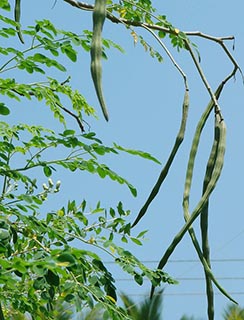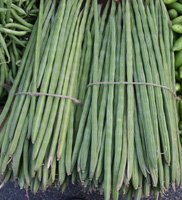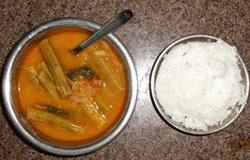Moringa Nutrition facts
Moringa oleifera, known popularly as drumstick tree, is a tropical plant grown for its nutritious leafy greens, flower buds, and mineral-rich, tender fruit pods.
Moringa is a well-recognized member of the Moringaceae family of trees and is thought to have originated in the sub-Himalayan forests of the Indian subcontinent. It possesses horseradish-like root and, hence, known to the West as horseradish tree. Their young, tender seed pods are popular as murangai in Tamil, and malunggay in the Philippines.
Scientific name: Moringa oleifera.
 |
| Moringa oliefera pods. Courtesy: Hafiz. |
Moringa is a drought-tolerant, medium-sized, evergreen tree that prefers warm, frost-free climates to flourish. Its tender leaves and twigs can be harvested at any time from a well-established, 1.5 to 2 meters tall plant.
A mature tree produces cream-white, small size flowers in clusters throughout the season that subsequently develop into long slender with tapering ends, deep-green, three-sided, edible fruit pods.
Moringa pod measures about 6-18 inches in length with constrictions at the seed nodes giving them a typical drumstick appearance. Inside, each pod features fleshy pulp and round pea-sized seed encased inside a wing-shaped coat (hull).
Health benefits of Moringa
Food scientists believe that the moringa plant possesses unique nutritional qualities that hold promise for millions of impoverished communities around the world who are in need of dietary supplements like protein, minerals, and vitamins.
Moringa leaves are an excellent source of protein which is a unique feature for any herbs and leafy greens in the entire plant kingdom. 100 g of fresh raw leaves carry 9.8 g of protein or about 17.5% of the daily required levels. Dry, powdered leaves indeed are an excellent sources source of several quality amino acids.
Fresh pods and seeds are an excellent source of oleic acid, a health-benefiting monounsaturated fat. Moringa, as a high-quality oilseed crop, can be grown alternatively to improve the nutrition levels of populations in many drought-prone regions of Africa and Asia.
Fresh leaves and growing tips of moringa are the richest sources of vitamin A. 100 g of fresh leaves carry 7564 IU or 252% of the daily required levels of vitamin A! This vitamin is one of the fat-soluble anti-oxidants offering several health benefits, including mucosal repair, maintenance of skin integrity, vision, and immunity.
Fresh moringa (drumstick) pods and leaves are excellent sources of vitamin C. 100 g of pods contain 145 µg or 235% of daily required levels of vitamin C. 100 g of greens provide 51.7 µg or 86% of daily-recommended intake values of this vitamin. Research studies have shown that consumption of fruits/vegetables rich in vitamin C helps the body develop immunity to combat infectious agents, and scavenge harmful oxygen-free radicals from the body.
Drumstick leaves, as well as pods, also contain good amounts of many vital B-complex vitamins such as folates, vitamin-B6 (pyridoxine), thiamin (vitamin B-1), riboflavin, pantothenic acid, and niacin. Many of these vitamins function as co-enzymes in carbohydrate, protein, and fat metabolism.
Furthermore, its greens (leaves) are one of the finest sources of minerals like calcium, iron, copper, manganese, zinc, selenium, and magnesium. Iron alleviates anemia. Calcium is essential for bone mineralization. Zinc plays a vital role in hair growth, spermatogenesis, and skin health.
Compare the Nutritive value per 100 g of Moringa (drumstick) pods and leaves in the profile table below:
| Principle | Nutrient value-Pods | Nutrient value-Leaves |
|---|---|---|
| Energy | 37 Kcal (2%) | 64 Kcal (3%) |
| Carbohydrates | 8.53 g (6.5%) | 8.28% (6%) |
| Protein | 2.10 g (4%) | 9.40 g (17%) |
| Total Fat | 0.20 g (1%) | 1.40% (7%) |
| Cholesterol | 0 mg (0%) | 0 mg (0%) |
| Dietary Fiber | 3.2 g (8%) | 2.0 g (5%) |
| Vitamins | ||
| Folates | 44 µg (11%) | 40 µg (10%) |
| Niacin | 0.680 mg (4%) | 2.220 mg (14%) |
| Pyridoxine | 0.120 mg (9%) | 1.200 mg (92%) |
| Riboflavin | 0.074 mg (6%) | 0.660 mg (51%) |
| Thiamin | 0.053 mg (4.5%) | 0.257 mg (21.5%) |
| Vitamin A | 74 IU (2.5%) | 7564 IU (252%) |
| Vitamin C | 141 mg (235%) | 51.7 mg (86%) |
| Electrolytes | ||
| Sodium | 42 mg (3%) | 9 mg (0.5%) |
| Potassium | 461 mg (10%) | 337 mg (7%) |
| Minerals | ||
| Calcium | 30 mg (3%) | 185 mg (18.5%) |
| Iron | 0.36 mg (4.5%) | 4.00 mg (50%) |
| Magnesium | 45 mg (11%) | 147 mg (37%) |
| Phosphorus | 50 mg (9%) | 112 mg (20%) |
| Selenium | 8.2 µg (15%) | 0.9 µg (1.5%) |
| Zinc | 0.45 mg (4%) | 0.60 mg (5%) |
Selection and storage
 |
| Moringa pods in a market. |
Fresh moringa pods and greens can be readily available in the markets all around the season in the tropical and sub-tropical countries of Southeast Asia, the Philippines, Middle-Eastern, Africa, the Caribbean, and some Central American regions. In the USA, the tree grows easily in the Southern States; however, only a few owners grow it in their backyard. Its consumption in the USA is mainly driven by several thousand expatriated communities of Asian and African backgrounds who prefer M. oleifera in their diet.
Fresh leaves, pods, and seed kernels can be found at the farmers' markets. Dry moringa leaf powder in bins and packs can be available in some specialized stores. At their nativity, moringa leaves are one of the inexpensive greens available in the markets. However, fresh pods and seeds command good prices even in the native Asian and African markets.
While buying fresh pods; look for just tender, uniform, evenly full, green color pods. Avoid dry, shriveled, bent, twisted, or broken pods. Do not buy overmature large size pods as they feature tougher skin, bitter pulp, and hard seeds and are thus unappetizing.
At home, moringa leaf should be maintained like any other green. Pods can keep well for 1-2 days at room temperature, however, should be stored in the refrigerator for extended shelf life.
Dried moringa leaf powder and capsules are also sold in the stores for their advocated health benefits across Europe and North America.
Preparation and serving methods
Fresh Moringa leaves, and tender seed pods used extensively in cooking in Asia, Africa, and Caribbean cuisine. Only tender growing tips and young leaves are employed as greens in the cooking. However, dried, and powdered green moringa leaves can be stored for extended periods to be used in the recipes (akin to dried fenugreek leaves-kasoori methi, in India and Pakistan).
Clean and wash them in cold water as you do in the case of other greens. To prepare fresh pods; clean them in cold water, mop dry using an absorbent paper towel. Trim the ends. Cut the pod to two inches long to add in soups, curries, etc. Clean the leaves as you do with other greens like fenugreek, purslane, spinach. Sift the leaves from the twig and discard the stem. Chop if you wish to do so, or else, entire greens can be added to the recipes.
Here are some serving tips:

|
| Moringa pods curry served with steamed rice, a special South-Indian recipe. |
Moringa pods and greens feature in the recipes on a regular basis in many Asian traditions. In the Philippines (malunggay), where they are marketed all around the season, its leaves are used liberally in soups, stews with fish, prawns, and poultry.
In traditional Senegalese recipe, moringa greens are employed to prepare sauce Mboum. Fresh leaves sautéed with onion, peanut butter, vegetable oil, smoked/dried fish, and seasoned with salt and pepper to taste.
In India and Pakistan, tender moringa pods known as sahajan, used in sahajan ki sabzi.
In South Indian states, both pods (murunga in Tamil) and greens are used in curries (sambar), soups, and stews.
In the Philippines, fresh leaves are cooked in coconut milk to prepare ginattang malunggay.
Dry and powdered moringa leaves can be added to the diet to improve the nutritional quality in Africa and Asia. Bread, muffins, pastry, rolls, and cakes can be prepared by mixing M.oleifera powder with wheat, maize, and rice flour.
Safety profile
Although moringa plant parts confer many health-benefiting qualities, it is advised to use them as a vegetable and not as medicine. Some traditional medicines and pharmaceuticals broadcast various healing properties of M.oleifera, which are yet to be approved by the scientific and research medical fraternity around the world.
Moringa root contains alkaloid spirochin, which is a potential neuro-paralytic toxin. Its leaves, when eaten in large quantities, may cause stomach upset, gaseous distension, and loose stools due to their laxative properties. (Medical disclaimer).
Also read ≻≻-
≻≻- Moringa (Drumstick) leaves nutrition facts.
≻≻-Back to Vegetables from Moringa nutrition. Visit here for an impressive list of vegetables with complete illustrations of their nutrition facts and health benefits.
≻≻-Back to Home page.
Further reading and references:
M. oliefera- Trees Of Life.
USDA -Drumstick pods: Nutrient Database for Standard Reference.
USDA -Drumstick leaves: Nutrient Database for Standard Reference.
Gopalan, C., B.V. Rama Sastri, and S.C. Balasubramanian. Nutritive value of Indian foods. Hyderabad, India: (National Institute of Nutrition), 1971 (revised and updated by B.S. Narasinga Rao, Y.G. Deosthale, and K.C. Pant, 1989).